Family Therapy: Techniques, Role of Therapist, and Cultural Considerations
VerifiedAdded on 2023/06/04
|15
|3906
|146
AI Summary
This article discusses the importance of family therapy in addressing mental health challenges. It covers the different types of families, the history of family counseling, and the role of the therapist in the process. It also explores various techniques used in family therapy, including Cognitive Behavioral Therapy, Structural Family Therapy, and Multisystem Therapy. Additionally, it highlights the importance of cultural considerations in Aotearoa New Zealand.
Contribute Materials
Your contribution can guide someone’s learning journey. Share your
documents today.
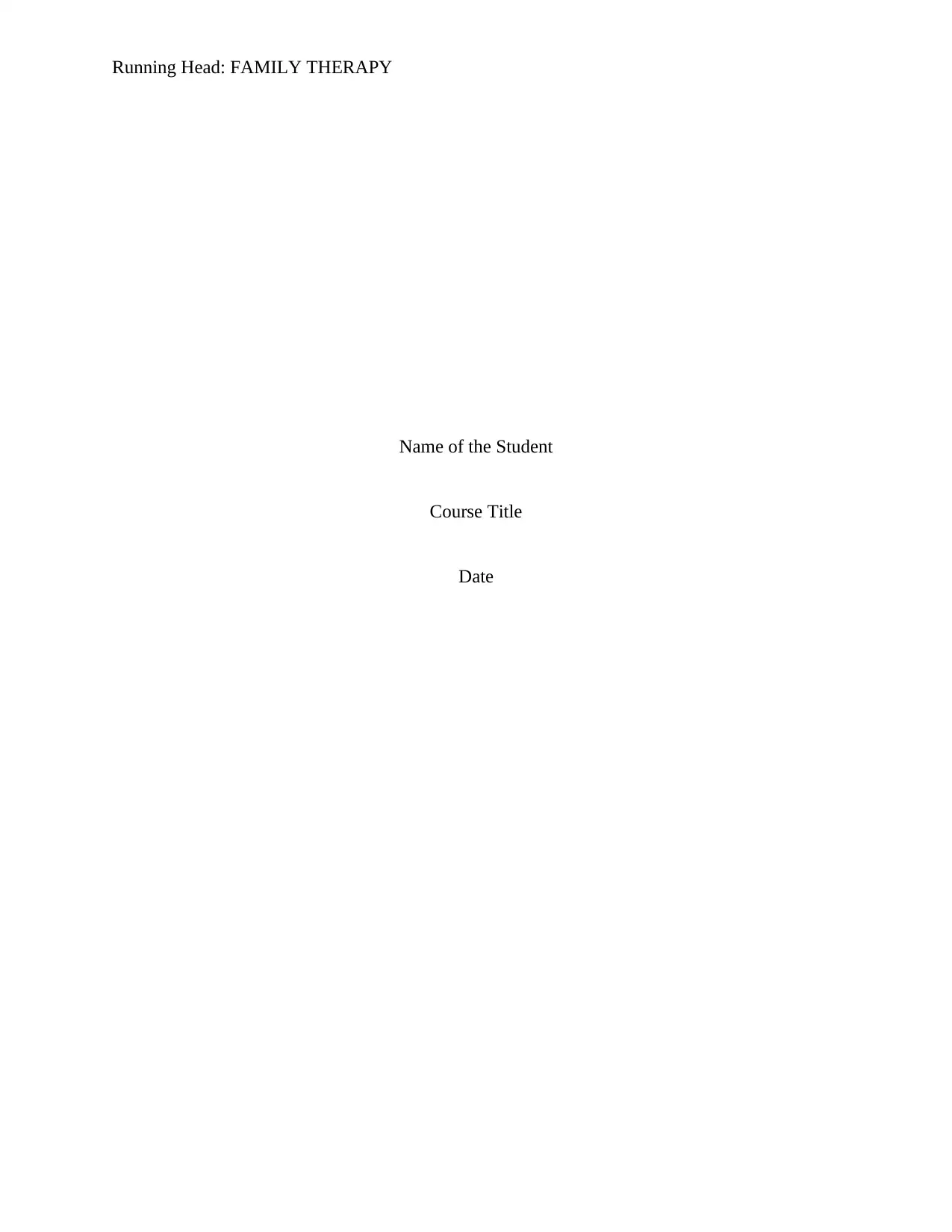
Running Head: FAMILY THERAPY
Name of the Student
Course Title
Date
Name of the Student
Course Title
Date
Secure Best Marks with AI Grader
Need help grading? Try our AI Grader for instant feedback on your assignments.
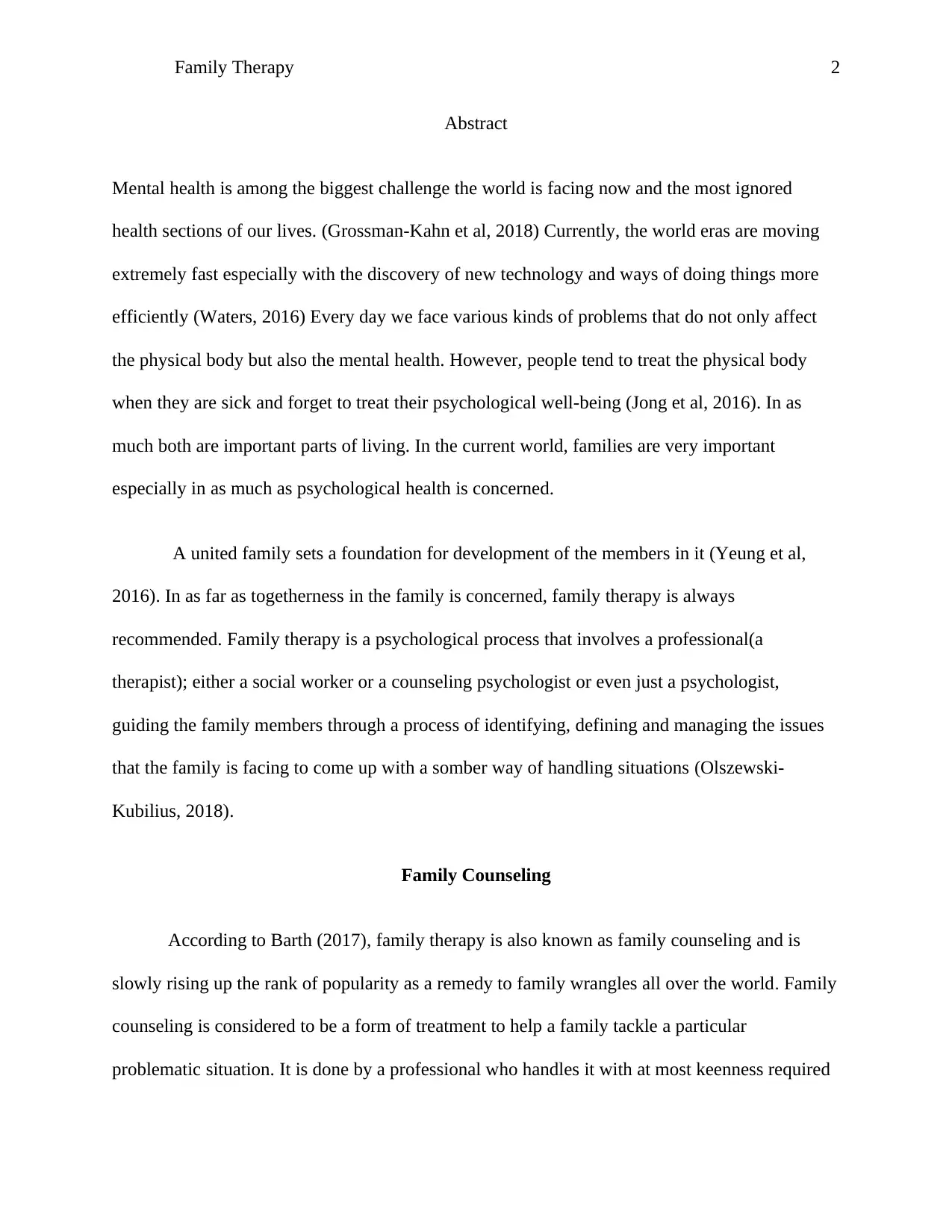
Family Therapy 2
Abstract
Mental health is among the biggest challenge the world is facing now and the most ignored
health sections of our lives. (Grossman‐Kahn et al, 2018) Currently, the world eras are moving
extremely fast especially with the discovery of new technology and ways of doing things more
efficiently (Waters, 2016) Every day we face various kinds of problems that do not only affect
the physical body but also the mental health. However, people tend to treat the physical body
when they are sick and forget to treat their psychological well-being (Jong et al, 2016). In as
much both are important parts of living. In the current world, families are very important
especially in as much as psychological health is concerned.
A united family sets a foundation for development of the members in it (Yeung et al,
2016). In as far as togetherness in the family is concerned, family therapy is always
recommended. Family therapy is a psychological process that involves a professional(a
therapist); either a social worker or a counseling psychologist or even just a psychologist,
guiding the family members through a process of identifying, defining and managing the issues
that the family is facing to come up with a somber way of handling situations (Olszewski-
Kubilius, 2018).
Family Counseling
According to Barth (2017), family therapy is also known as family counseling and is
slowly rising up the rank of popularity as a remedy to family wrangles all over the world. Family
counseling is considered to be a form of treatment to help a family tackle a particular
problematic situation. It is done by a professional who handles it with at most keenness required
Abstract
Mental health is among the biggest challenge the world is facing now and the most ignored
health sections of our lives. (Grossman‐Kahn et al, 2018) Currently, the world eras are moving
extremely fast especially with the discovery of new technology and ways of doing things more
efficiently (Waters, 2016) Every day we face various kinds of problems that do not only affect
the physical body but also the mental health. However, people tend to treat the physical body
when they are sick and forget to treat their psychological well-being (Jong et al, 2016). In as
much both are important parts of living. In the current world, families are very important
especially in as much as psychological health is concerned.
A united family sets a foundation for development of the members in it (Yeung et al,
2016). In as far as togetherness in the family is concerned, family therapy is always
recommended. Family therapy is a psychological process that involves a professional(a
therapist); either a social worker or a counseling psychologist or even just a psychologist,
guiding the family members through a process of identifying, defining and managing the issues
that the family is facing to come up with a somber way of handling situations (Olszewski-
Kubilius, 2018).
Family Counseling
According to Barth (2017), family therapy is also known as family counseling and is
slowly rising up the rank of popularity as a remedy to family wrangles all over the world. Family
counseling is considered to be a form of treatment to help a family tackle a particular
problematic situation. It is done by a professional who handles it with at most keenness required

Family Therapy 3
to start the healing process. Becvar et al (2017) states that it involves several theories that are put
into practice by a therapist or professional to make sure a universal way of handling similar kinds
of problems. In as much as the healing process may differ from one person to another, it has been
proven scientifically to work (Willig & Rogers, 2017). The rate of the healing process depends
on how willing the client is to change and share the issues that are affecting him or her, and how
they respond towards the healing process.
According to Barth (2018), family therapy follows the normal counseling procedure only
that this time the theories, therapeutic styles, strategies and methods used have been specifically
channeled to help in family healing. Family counseling involves counseling the family in a
conjoint process, considering the family as a unit and not a single person within the existing
family. The therapeutic styles used have been used over the years and proven to be medicinal to
the mind in as much as most of the diseases treated are unseen. Mental illnesses may be unseen
but their effect are felt to the entire body and if not treated early may make the victim psychiatric
or even in worse cases they may cause death (Hawthorne et al , 2016).
Understanding of the family
When dealing with family counseling, it is vital to understand what a family is. However,
there have been various descriptions of what a family is and none of them is universally
acceptable by everyone as the actual definition of family. For example, as stipulated by the
words of Desmond Tutu on a family, “You do not choose your family, and they are God’s gift to
you as you are to them.” He poses family as God’s gift unlike other people’s understanding
(Bell, 2017).
to start the healing process. Becvar et al (2017) states that it involves several theories that are put
into practice by a therapist or professional to make sure a universal way of handling similar kinds
of problems. In as much as the healing process may differ from one person to another, it has been
proven scientifically to work (Willig & Rogers, 2017). The rate of the healing process depends
on how willing the client is to change and share the issues that are affecting him or her, and how
they respond towards the healing process.
According to Barth (2018), family therapy follows the normal counseling procedure only
that this time the theories, therapeutic styles, strategies and methods used have been specifically
channeled to help in family healing. Family counseling involves counseling the family in a
conjoint process, considering the family as a unit and not a single person within the existing
family. The therapeutic styles used have been used over the years and proven to be medicinal to
the mind in as much as most of the diseases treated are unseen. Mental illnesses may be unseen
but their effect are felt to the entire body and if not treated early may make the victim psychiatric
or even in worse cases they may cause death (Hawthorne et al , 2016).
Understanding of the family
When dealing with family counseling, it is vital to understand what a family is. However,
there have been various descriptions of what a family is and none of them is universally
acceptable by everyone as the actual definition of family. For example, as stipulated by the
words of Desmond Tutu on a family, “You do not choose your family, and they are God’s gift to
you as you are to them.” He poses family as God’s gift unlike other people’s understanding
(Bell, 2017).
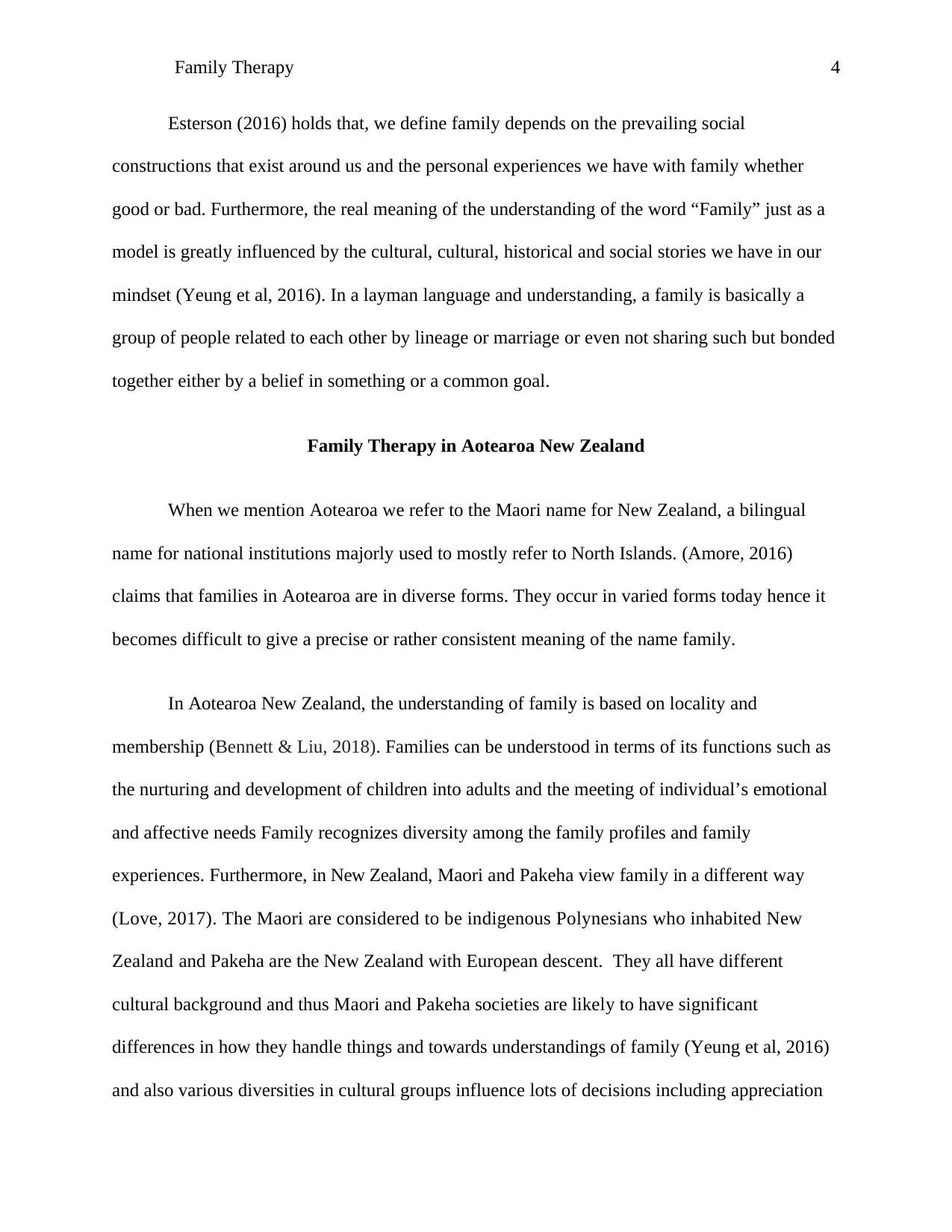
Family Therapy 4
Esterson (2016) holds that, we define family depends on the prevailing social
constructions that exist around us and the personal experiences we have with family whether
good or bad. Furthermore, the real meaning of the understanding of the word “Family” just as a
model is greatly influenced by the cultural, cultural, historical and social stories we have in our
mindset (Yeung et al, 2016). In a layman language and understanding, a family is basically a
group of people related to each other by lineage or marriage or even not sharing such but bonded
together either by a belief in something or a common goal.
Family Therapy in Aotearoa New Zealand
When we mention Aotearoa we refer to the Maori name for New Zealand, a bilingual
name for national institutions majorly used to mostly refer to North Islands. (Amore, 2016)
claims that families in Aotearoa are in diverse forms. They occur in varied forms today hence it
becomes difficult to give a precise or rather consistent meaning of the name family.
In Aotearoa New Zealand, the understanding of family is based on locality and
membership (Bennett & Liu, 2018). Families can be understood in terms of its functions such as
the nurturing and development of children into adults and the meeting of individual’s emotional
and affective needs Family recognizes diversity among the family profiles and family
experiences. Furthermore, in New Zealand, Maori and Pakeha view family in a different way
(Love, 2017). The Maori are considered to be indigenous Polynesians who inhabited New
Zealand and Pakeha are the New Zealand with European descent. They all have different
cultural background and thus Maori and Pakeha societies are likely to have significant
differences in how they handle things and towards understandings of family (Yeung et al, 2016)
and also various diversities in cultural groups influence lots of decisions including appreciation
Esterson (2016) holds that, we define family depends on the prevailing social
constructions that exist around us and the personal experiences we have with family whether
good or bad. Furthermore, the real meaning of the understanding of the word “Family” just as a
model is greatly influenced by the cultural, cultural, historical and social stories we have in our
mindset (Yeung et al, 2016). In a layman language and understanding, a family is basically a
group of people related to each other by lineage or marriage or even not sharing such but bonded
together either by a belief in something or a common goal.
Family Therapy in Aotearoa New Zealand
When we mention Aotearoa we refer to the Maori name for New Zealand, a bilingual
name for national institutions majorly used to mostly refer to North Islands. (Amore, 2016)
claims that families in Aotearoa are in diverse forms. They occur in varied forms today hence it
becomes difficult to give a precise or rather consistent meaning of the name family.
In Aotearoa New Zealand, the understanding of family is based on locality and
membership (Bennett & Liu, 2018). Families can be understood in terms of its functions such as
the nurturing and development of children into adults and the meeting of individual’s emotional
and affective needs Family recognizes diversity among the family profiles and family
experiences. Furthermore, in New Zealand, Maori and Pakeha view family in a different way
(Love, 2017). The Maori are considered to be indigenous Polynesians who inhabited New
Zealand and Pakeha are the New Zealand with European descent. They all have different
cultural background and thus Maori and Pakeha societies are likely to have significant
differences in how they handle things and towards understandings of family (Yeung et al, 2016)
and also various diversities in cultural groups influence lots of decisions including appreciation
Secure Best Marks with AI Grader
Need help grading? Try our AI Grader for instant feedback on your assignments.
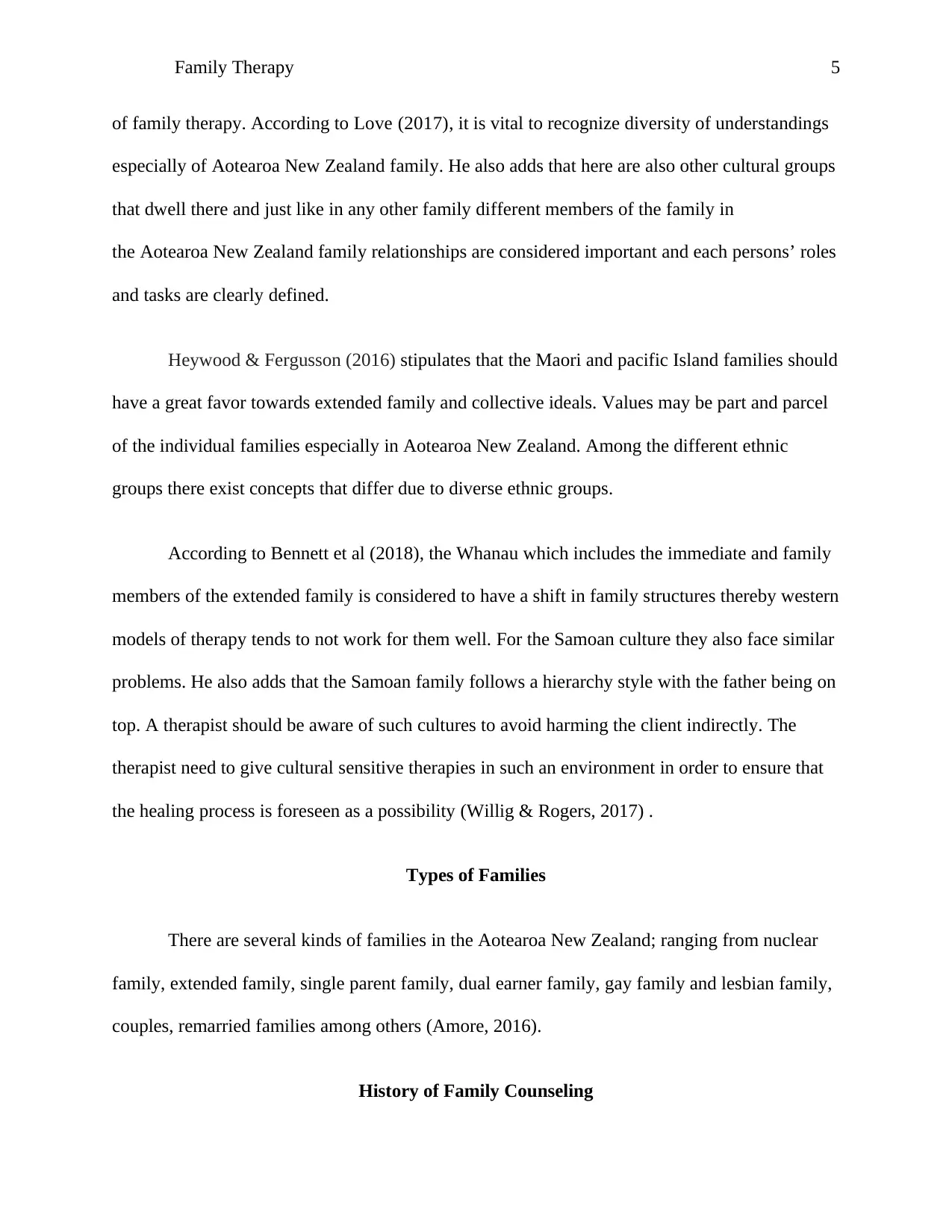
Family Therapy 5
of family therapy. According to Love (2017), it is vital to recognize diversity of understandings
especially of Aotearoa New Zealand family. He also adds that here are also other cultural groups
that dwell there and just like in any other family different members of the family in
the Aotearoa New Zealand family relationships are considered important and each persons’ roles
and tasks are clearly defined.
Heywood & Fergusson (2016) stipulates that the Maori and pacific Island families should
have a great favor towards extended family and collective ideals. Values may be part and parcel
of the individual families especially in Aotearoa New Zealand. Among the different ethnic
groups there exist concepts that differ due to diverse ethnic groups.
According to Bennett et al (2018), the Whanau which includes the immediate and family
members of the extended family is considered to have a shift in family structures thereby western
models of therapy tends to not work for them well. For the Samoan culture they also face similar
problems. He also adds that the Samoan family follows a hierarchy style with the father being on
top. A therapist should be aware of such cultures to avoid harming the client indirectly. The
therapist need to give cultural sensitive therapies in such an environment in order to ensure that
the healing process is foreseen as a possibility (Willig & Rogers, 2017) .
Types of Families
There are several kinds of families in the Aotearoa New Zealand; ranging from nuclear
family, extended family, single parent family, dual earner family, gay family and lesbian family,
couples, remarried families among others (Amore, 2016).
History of Family Counseling
of family therapy. According to Love (2017), it is vital to recognize diversity of understandings
especially of Aotearoa New Zealand family. He also adds that here are also other cultural groups
that dwell there and just like in any other family different members of the family in
the Aotearoa New Zealand family relationships are considered important and each persons’ roles
and tasks are clearly defined.
Heywood & Fergusson (2016) stipulates that the Maori and pacific Island families should
have a great favor towards extended family and collective ideals. Values may be part and parcel
of the individual families especially in Aotearoa New Zealand. Among the different ethnic
groups there exist concepts that differ due to diverse ethnic groups.
According to Bennett et al (2018), the Whanau which includes the immediate and family
members of the extended family is considered to have a shift in family structures thereby western
models of therapy tends to not work for them well. For the Samoan culture they also face similar
problems. He also adds that the Samoan family follows a hierarchy style with the father being on
top. A therapist should be aware of such cultures to avoid harming the client indirectly. The
therapist need to give cultural sensitive therapies in such an environment in order to ensure that
the healing process is foreseen as a possibility (Willig & Rogers, 2017) .
Types of Families
There are several kinds of families in the Aotearoa New Zealand; ranging from nuclear
family, extended family, single parent family, dual earner family, gay family and lesbian family,
couples, remarried families among others (Amore, 2016).
History of Family Counseling

Family Therapy 6
According to (Pedersen et al 2016), interventions to help deal with family issues have
been existing probably as early as history. Problems in families have always existed. However,
formal records of family therapy can be traced backed to Talbot Parsons paradigm in 1954. It
brought to light the functional and structural views of family to assist in family wrangles. His
paradigm stipulated the specified roles of family members distinguishing the male and females
and gave out an acceptable standard of such roles. This therapeutic view was believed to be
applicable universally.
However, it faced a major criticism that it was male dominated (patriarchal) and also
culturally insensitive. It did not consider the various parameters which family can be understood.
For this reason, cultural inclusive, sensitive and competent therapies were advanced to move
away from the initial therapy which was considered quite barbaric (Pedersen et al 2016).
Currently, there are very many therapeutic styles used by practitioners as a substitute for the non-
convenient styles that were initially used. The number of therapist also has increased
tremendously to cater for the ever increasing cases day by day (Willig & Rogers, 2017).
Role of the Therapist in Family Therapy
The therapist has a big role to play especially when practicing family therapy in New
Zealand because of the varied cultural disparities and ethnicities (Kennerley et al 2016). Other
than the usual role of diagnosing and treating psychological issues, the therapist has a role to
ensure they deliver the therapy in accordance with the culture and specifications of the client.
This should be without transferring their personal opinion to judge the client’s cultural
beliefs (Kottler, 2017).
According to (Pedersen et al 2016), interventions to help deal with family issues have
been existing probably as early as history. Problems in families have always existed. However,
formal records of family therapy can be traced backed to Talbot Parsons paradigm in 1954. It
brought to light the functional and structural views of family to assist in family wrangles. His
paradigm stipulated the specified roles of family members distinguishing the male and females
and gave out an acceptable standard of such roles. This therapeutic view was believed to be
applicable universally.
However, it faced a major criticism that it was male dominated (patriarchal) and also
culturally insensitive. It did not consider the various parameters which family can be understood.
For this reason, cultural inclusive, sensitive and competent therapies were advanced to move
away from the initial therapy which was considered quite barbaric (Pedersen et al 2016).
Currently, there are very many therapeutic styles used by practitioners as a substitute for the non-
convenient styles that were initially used. The number of therapist also has increased
tremendously to cater for the ever increasing cases day by day (Willig & Rogers, 2017).
Role of the Therapist in Family Therapy
The therapist has a big role to play especially when practicing family therapy in New
Zealand because of the varied cultural disparities and ethnicities (Kennerley et al 2016). Other
than the usual role of diagnosing and treating psychological issues, the therapist has a role to
ensure they deliver the therapy in accordance with the culture and specifications of the client.
This should be without transferring their personal opinion to judge the client’s cultural
beliefs (Kottler, 2017).

Family Therapy 7
According to (Pedersen et al 2016), the therapist should consider individualism to avoid
interference with the client cultural beliefs. He also adds that the therapist plays the role of
listening to the client and respond accordingly to the fears and insecurities giving assurance and
hope for the client. Furthermore, he states that the therapist is the initiator of the counseling
process and terminator of the entire process after ensuring the healing process has been achieved
The therapist should ensure that he or she gets a broad understanding of the client
historical background before tackling an issue at hand to avoid misinterpretation of information
using the wrong culture as the yard stick to judge the problem at hand (Burck, 2018).
The therapist has to play other roles such as observing how the family or the client
interacts within a session noting the non-verbal cues used. This will be important in prescribing
the tasks to be completed with the client. Furthermore, the counselor helps the client transition
past the crisis points they get Kennerley et al (2016).
Family Therapy and Techniques Used in Counseling
There are different styles or types of psychotherapeutic interventions under family
therapy. They have been erupting day by day ever since early 1950s in Aotearoa New Zealand.
Larner (2017) claims that, some new and highly accepted therapies have emerged from the wide
spread theoretical models that were formulated during this period. Some of the styles include;
Cognitive Behavioral Therapy(CBT)
Structural Family Therapy(SFT)
Multisystematic Therapy(MST)
Functional Family Therapy (FFT)
According to (Pedersen et al 2016), the therapist should consider individualism to avoid
interference with the client cultural beliefs. He also adds that the therapist plays the role of
listening to the client and respond accordingly to the fears and insecurities giving assurance and
hope for the client. Furthermore, he states that the therapist is the initiator of the counseling
process and terminator of the entire process after ensuring the healing process has been achieved
The therapist should ensure that he or she gets a broad understanding of the client
historical background before tackling an issue at hand to avoid misinterpretation of information
using the wrong culture as the yard stick to judge the problem at hand (Burck, 2018).
The therapist has to play other roles such as observing how the family or the client
interacts within a session noting the non-verbal cues used. This will be important in prescribing
the tasks to be completed with the client. Furthermore, the counselor helps the client transition
past the crisis points they get Kennerley et al (2016).
Family Therapy and Techniques Used in Counseling
There are different styles or types of psychotherapeutic interventions under family
therapy. They have been erupting day by day ever since early 1950s in Aotearoa New Zealand.
Larner (2017) claims that, some new and highly accepted therapies have emerged from the wide
spread theoretical models that were formulated during this period. Some of the styles include;
Cognitive Behavioral Therapy(CBT)
Structural Family Therapy(SFT)
Multisystematic Therapy(MST)
Functional Family Therapy (FFT)
Paraphrase This Document
Need a fresh take? Get an instant paraphrase of this document with our AI Paraphraser
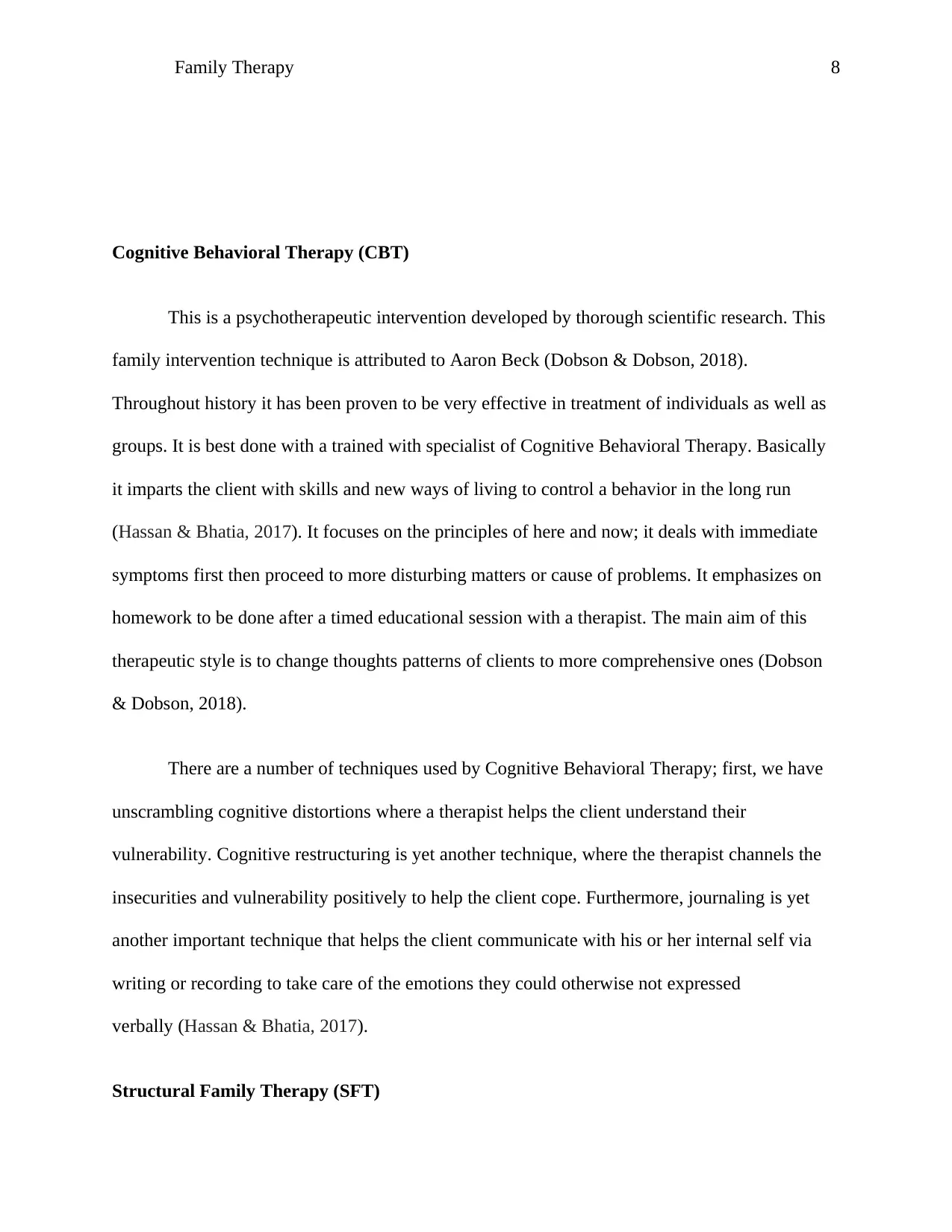
Family Therapy 8
Cognitive Behavioral Therapy (CBT)
This is a psychotherapeutic intervention developed by thorough scientific research. This
family intervention technique is attributed to Aaron Beck (Dobson & Dobson, 2018).
Throughout history it has been proven to be very effective in treatment of individuals as well as
groups. It is best done with a trained with specialist of Cognitive Behavioral Therapy. Basically
it imparts the client with skills and new ways of living to control a behavior in the long run
(Hassan & Bhatia, 2017). It focuses on the principles of here and now; it deals with immediate
symptoms first then proceed to more disturbing matters or cause of problems. It emphasizes on
homework to be done after a timed educational session with a therapist. The main aim of this
therapeutic style is to change thoughts patterns of clients to more comprehensive ones (Dobson
& Dobson, 2018).
There are a number of techniques used by Cognitive Behavioral Therapy; first, we have
unscrambling cognitive distortions where a therapist helps the client understand their
vulnerability. Cognitive restructuring is yet another technique, where the therapist channels the
insecurities and vulnerability positively to help the client cope. Furthermore, journaling is yet
another important technique that helps the client communicate with his or her internal self via
writing or recording to take care of the emotions they could otherwise not expressed
verbally (Hassan & Bhatia, 2017).
Structural Family Therapy (SFT)
Cognitive Behavioral Therapy (CBT)
This is a psychotherapeutic intervention developed by thorough scientific research. This
family intervention technique is attributed to Aaron Beck (Dobson & Dobson, 2018).
Throughout history it has been proven to be very effective in treatment of individuals as well as
groups. It is best done with a trained with specialist of Cognitive Behavioral Therapy. Basically
it imparts the client with skills and new ways of living to control a behavior in the long run
(Hassan & Bhatia, 2017). It focuses on the principles of here and now; it deals with immediate
symptoms first then proceed to more disturbing matters or cause of problems. It emphasizes on
homework to be done after a timed educational session with a therapist. The main aim of this
therapeutic style is to change thoughts patterns of clients to more comprehensive ones (Dobson
& Dobson, 2018).
There are a number of techniques used by Cognitive Behavioral Therapy; first, we have
unscrambling cognitive distortions where a therapist helps the client understand their
vulnerability. Cognitive restructuring is yet another technique, where the therapist channels the
insecurities and vulnerability positively to help the client cope. Furthermore, journaling is yet
another important technique that helps the client communicate with his or her internal self via
writing or recording to take care of the emotions they could otherwise not expressed
verbally (Hassan & Bhatia, 2017).
Structural Family Therapy (SFT)
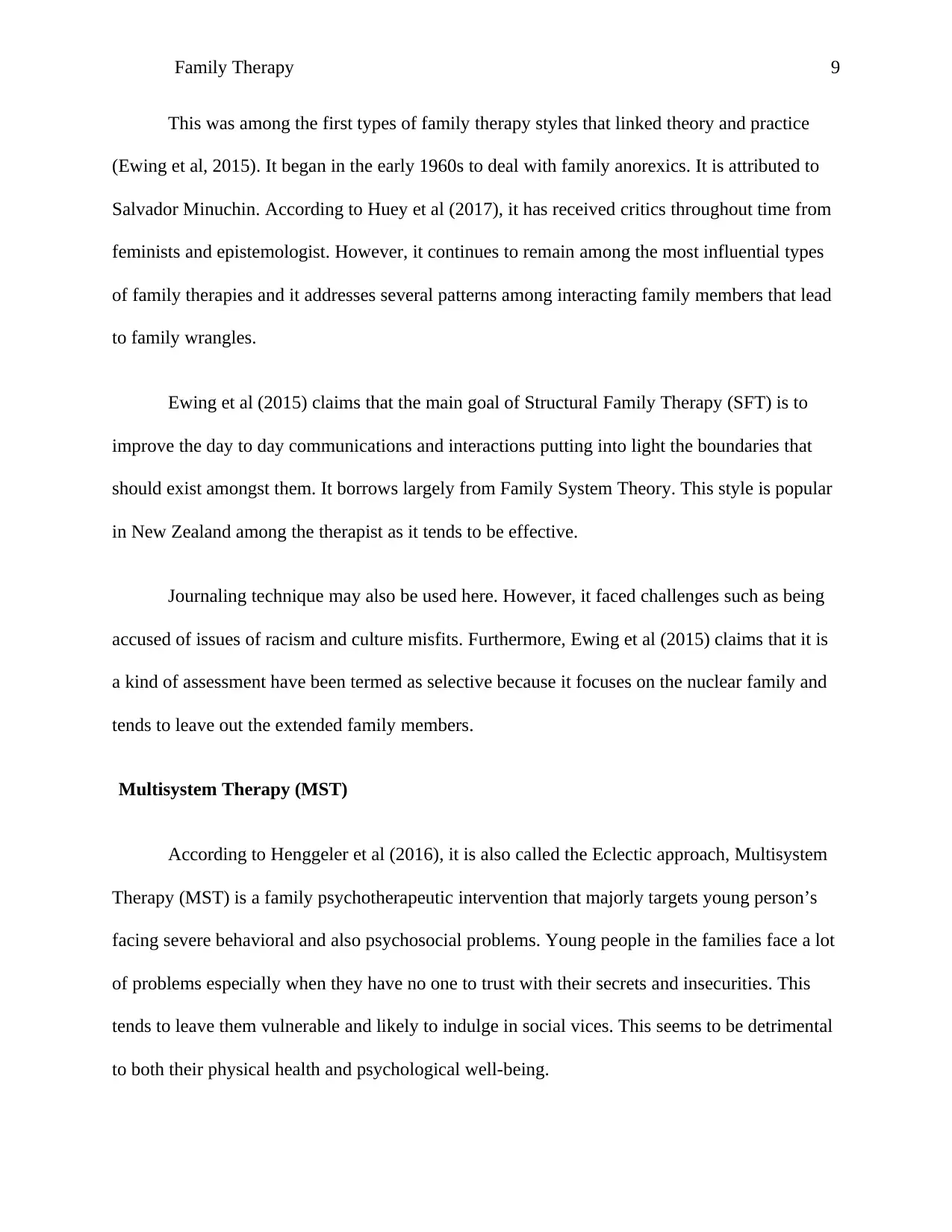
Family Therapy 9
This was among the first types of family therapy styles that linked theory and practice
(Ewing et al, 2015). It began in the early 1960s to deal with family anorexics. It is attributed to
Salvador Minuchin. According to Huey et al (2017), it has received critics throughout time from
feminists and epistemologist. However, it continues to remain among the most influential types
of family therapies and it addresses several patterns among interacting family members that lead
to family wrangles.
Ewing et al (2015) claims that the main goal of Structural Family Therapy (SFT) is to
improve the day to day communications and interactions putting into light the boundaries that
should exist amongst them. It borrows largely from Family System Theory. This style is popular
in New Zealand among the therapist as it tends to be effective.
Journaling technique may also be used here. However, it faced challenges such as being
accused of issues of racism and culture misfits. Furthermore, Ewing et al (2015) claims that it is
a kind of assessment have been termed as selective because it focuses on the nuclear family and
tends to leave out the extended family members.
Multisystem Therapy (MST)
According to Henggeler et al (2016), it is also called the Eclectic approach, Multisystem
Therapy (MST) is a family psychotherapeutic intervention that majorly targets young person’s
facing severe behavioral and also psychosocial problems. Young people in the families face a lot
of problems especially when they have no one to trust with their secrets and insecurities. This
tends to leave them vulnerable and likely to indulge in social vices. This seems to be detrimental
to both their physical health and psychological well-being.
This was among the first types of family therapy styles that linked theory and practice
(Ewing et al, 2015). It began in the early 1960s to deal with family anorexics. It is attributed to
Salvador Minuchin. According to Huey et al (2017), it has received critics throughout time from
feminists and epistemologist. However, it continues to remain among the most influential types
of family therapies and it addresses several patterns among interacting family members that lead
to family wrangles.
Ewing et al (2015) claims that the main goal of Structural Family Therapy (SFT) is to
improve the day to day communications and interactions putting into light the boundaries that
should exist amongst them. It borrows largely from Family System Theory. This style is popular
in New Zealand among the therapist as it tends to be effective.
Journaling technique may also be used here. However, it faced challenges such as being
accused of issues of racism and culture misfits. Furthermore, Ewing et al (2015) claims that it is
a kind of assessment have been termed as selective because it focuses on the nuclear family and
tends to leave out the extended family members.
Multisystem Therapy (MST)
According to Henggeler et al (2016), it is also called the Eclectic approach, Multisystem
Therapy (MST) is a family psychotherapeutic intervention that majorly targets young person’s
facing severe behavioral and also psychosocial problems. Young people in the families face a lot
of problems especially when they have no one to trust with their secrets and insecurities. This
tends to leave them vulnerable and likely to indulge in social vices. This seems to be detrimental
to both their physical health and psychological well-being.
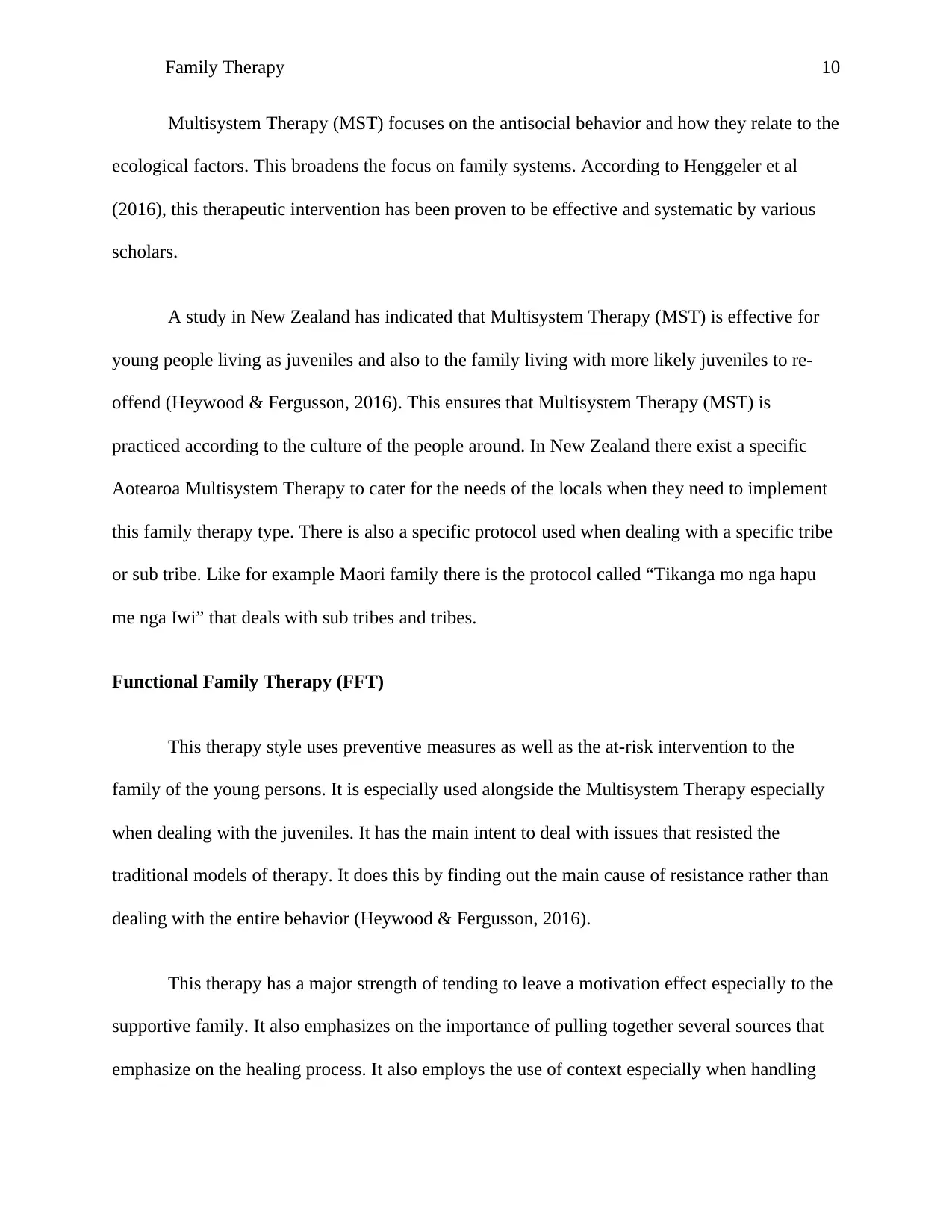
Family Therapy 10
Multisystem Therapy (MST) focuses on the antisocial behavior and how they relate to the
ecological factors. This broadens the focus on family systems. According to Henggeler et al
(2016), this therapeutic intervention has been proven to be effective and systematic by various
scholars.
A study in New Zealand has indicated that Multisystem Therapy (MST) is effective for
young people living as juveniles and also to the family living with more likely juveniles to re-
offend (Heywood & Fergusson, 2016). This ensures that Multisystem Therapy (MST) is
practiced according to the culture of the people around. In New Zealand there exist a specific
Aotearoa Multisystem Therapy to cater for the needs of the locals when they need to implement
this family therapy type. There is also a specific protocol used when dealing with a specific tribe
or sub tribe. Like for example Maori family there is the protocol called “Tikanga mo nga hapu
me nga Iwi” that deals with sub tribes and tribes.
Functional Family Therapy (FFT)
This therapy style uses preventive measures as well as the at-risk intervention to the
family of the young persons. It is especially used alongside the Multisystem Therapy especially
when dealing with the juveniles. It has the main intent to deal with issues that resisted the
traditional models of therapy. It does this by finding out the main cause of resistance rather than
dealing with the entire behavior (Heywood & Fergusson, 2016).
This therapy has a major strength of tending to leave a motivation effect especially to the
supportive family. It also emphasizes on the importance of pulling together several sources that
emphasize on the healing process. It also employs the use of context especially when handling
Multisystem Therapy (MST) focuses on the antisocial behavior and how they relate to the
ecological factors. This broadens the focus on family systems. According to Henggeler et al
(2016), this therapeutic intervention has been proven to be effective and systematic by various
scholars.
A study in New Zealand has indicated that Multisystem Therapy (MST) is effective for
young people living as juveniles and also to the family living with more likely juveniles to re-
offend (Heywood & Fergusson, 2016). This ensures that Multisystem Therapy (MST) is
practiced according to the culture of the people around. In New Zealand there exist a specific
Aotearoa Multisystem Therapy to cater for the needs of the locals when they need to implement
this family therapy type. There is also a specific protocol used when dealing with a specific tribe
or sub tribe. Like for example Maori family there is the protocol called “Tikanga mo nga hapu
me nga Iwi” that deals with sub tribes and tribes.
Functional Family Therapy (FFT)
This therapy style uses preventive measures as well as the at-risk intervention to the
family of the young persons. It is especially used alongside the Multisystem Therapy especially
when dealing with the juveniles. It has the main intent to deal with issues that resisted the
traditional models of therapy. It does this by finding out the main cause of resistance rather than
dealing with the entire behavior (Heywood & Fergusson, 2016).
This therapy has a major strength of tending to leave a motivation effect especially to the
supportive family. It also emphasizes on the importance of pulling together several sources that
emphasize on the healing process. It also employs the use of context especially when handling
Secure Best Marks with AI Grader
Need help grading? Try our AI Grader for instant feedback on your assignments.
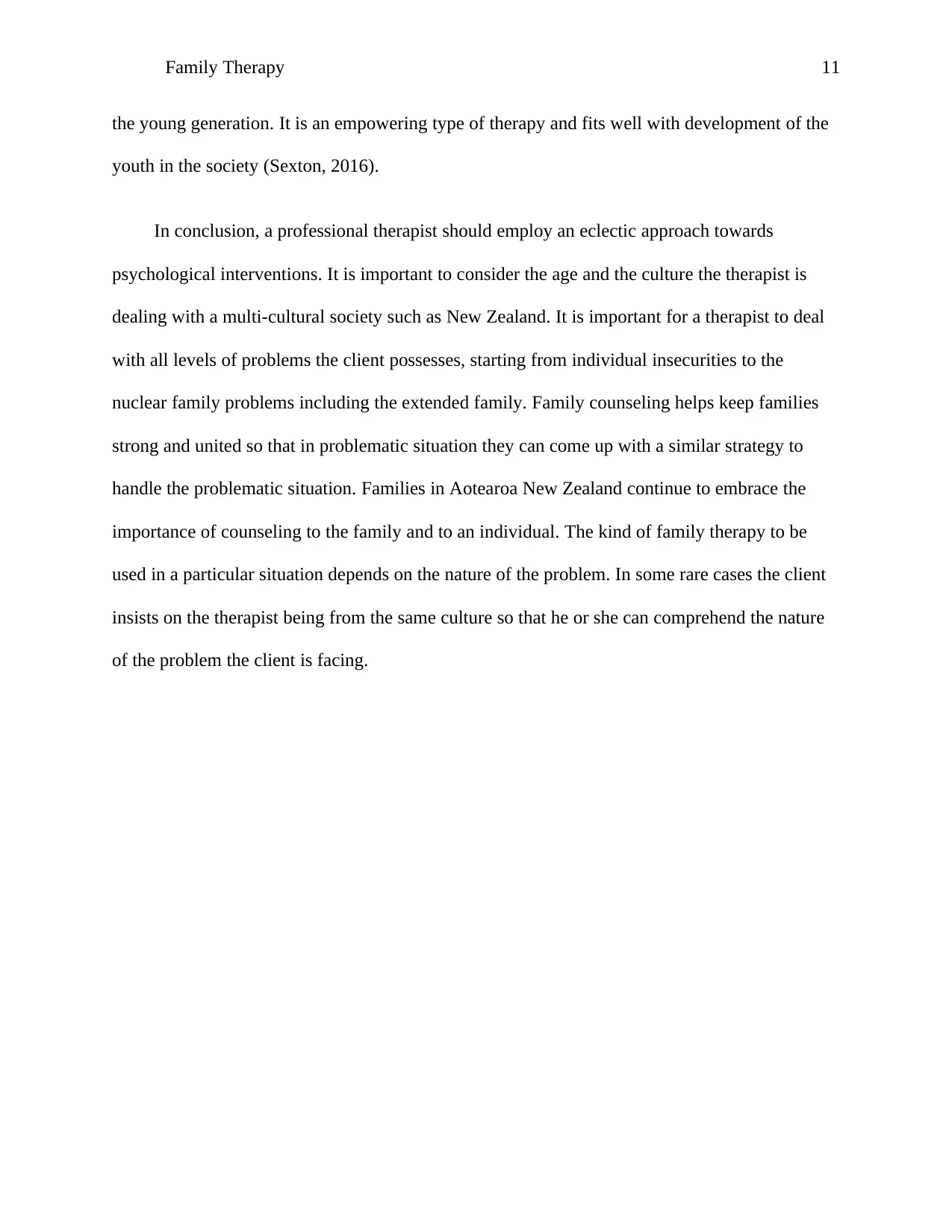
Family Therapy 11
the young generation. It is an empowering type of therapy and fits well with development of the
youth in the society (Sexton, 2016).
In conclusion, a professional therapist should employ an eclectic approach towards
psychological interventions. It is important to consider the age and the culture the therapist is
dealing with a multi-cultural society such as New Zealand. It is important for a therapist to deal
with all levels of problems the client possesses, starting from individual insecurities to the
nuclear family problems including the extended family. Family counseling helps keep families
strong and united so that in problematic situation they can come up with a similar strategy to
handle the problematic situation. Families in Aotearoa New Zealand continue to embrace the
importance of counseling to the family and to an individual. The kind of family therapy to be
used in a particular situation depends on the nature of the problem. In some rare cases the client
insists on the therapist being from the same culture so that he or she can comprehend the nature
of the problem the client is facing.
the young generation. It is an empowering type of therapy and fits well with development of the
youth in the society (Sexton, 2016).
In conclusion, a professional therapist should employ an eclectic approach towards
psychological interventions. It is important to consider the age and the culture the therapist is
dealing with a multi-cultural society such as New Zealand. It is important for a therapist to deal
with all levels of problems the client possesses, starting from individual insecurities to the
nuclear family problems including the extended family. Family counseling helps keep families
strong and united so that in problematic situation they can come up with a similar strategy to
handle the problematic situation. Families in Aotearoa New Zealand continue to embrace the
importance of counseling to the family and to an individual. The kind of family therapy to be
used in a particular situation depends on the nature of the problem. In some rare cases the client
insists on the therapist being from the same culture so that he or she can comprehend the nature
of the problem the client is facing.
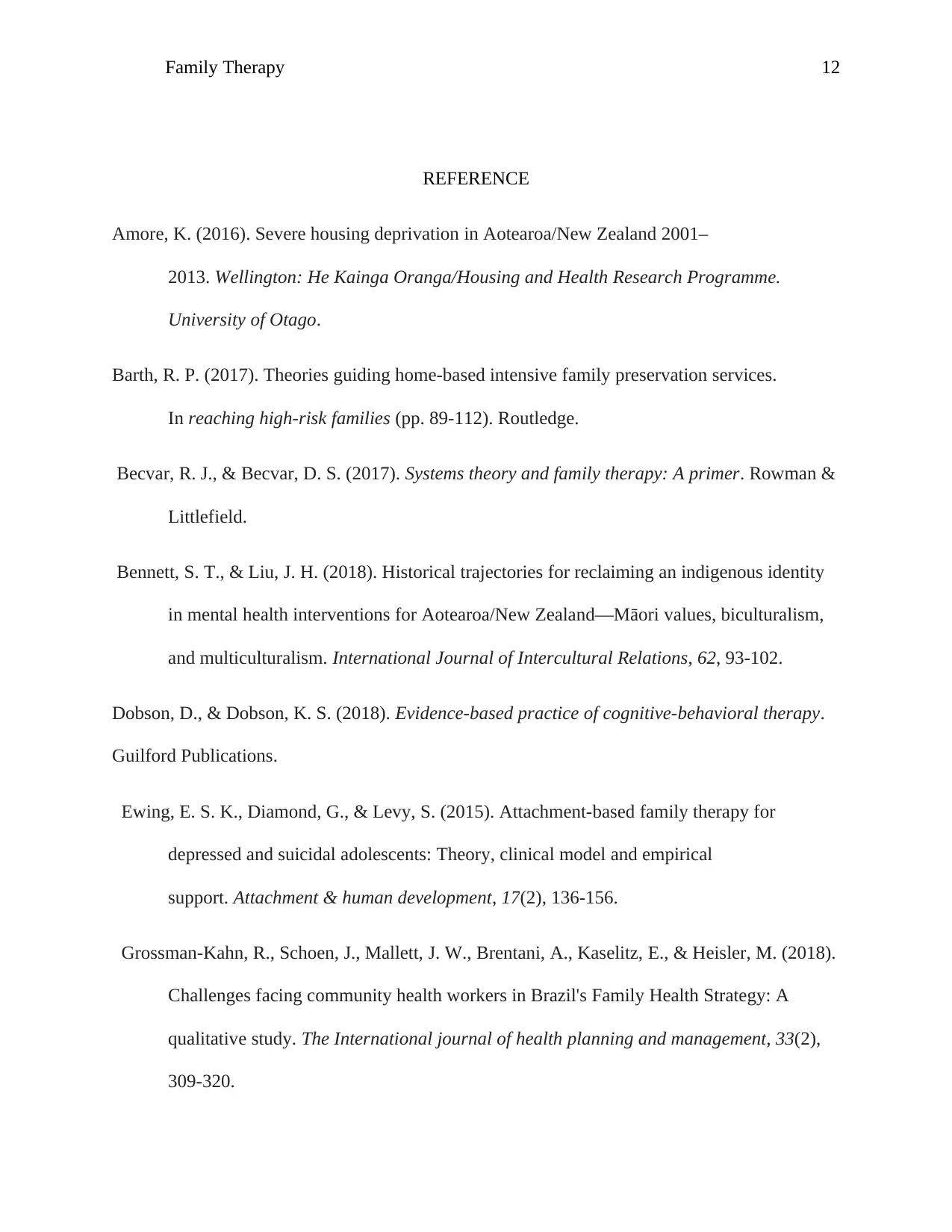
Family Therapy 12
REFERENCE
Amore, K. (2016). Severe housing deprivation in Aotearoa/New Zealand 2001–
2013. Wellington: He Kainga Oranga/Housing and Health Research Programme.
University of Otago.
Barth, R. P. (2017). Theories guiding home-based intensive family preservation services.
In reaching high-risk families (pp. 89-112). Routledge.
Becvar, R. J., & Becvar, D. S. (2017). Systems theory and family therapy: A primer. Rowman &
Littlefield.
Bennett, S. T., & Liu, J. H. (2018). Historical trajectories for reclaiming an indigenous identity
in mental health interventions for Aotearoa/New Zealand—Māori values, biculturalism,
and multiculturalism. International Journal of Intercultural Relations, 62, 93-102.
Dobson, D., & Dobson, K. S. (2018). Evidence-based practice of cognitive-behavioral therapy.
Guilford Publications.
Ewing, E. S. K., Diamond, G., & Levy, S. (2015). Attachment-based family therapy for
depressed and suicidal adolescents: Theory, clinical model and empirical
support. Attachment & human development, 17(2), 136-156.
Grossman‐Kahn, R., Schoen, J., Mallett, J. W., Brentani, A., Kaselitz, E., & Heisler, M. (2018).
Challenges facing community health workers in Brazil's Family Health Strategy: A
qualitative study. The International journal of health planning and management, 33(2),
309-320.
REFERENCE
Amore, K. (2016). Severe housing deprivation in Aotearoa/New Zealand 2001–
2013. Wellington: He Kainga Oranga/Housing and Health Research Programme.
University of Otago.
Barth, R. P. (2017). Theories guiding home-based intensive family preservation services.
In reaching high-risk families (pp. 89-112). Routledge.
Becvar, R. J., & Becvar, D. S. (2017). Systems theory and family therapy: A primer. Rowman &
Littlefield.
Bennett, S. T., & Liu, J. H. (2018). Historical trajectories for reclaiming an indigenous identity
in mental health interventions for Aotearoa/New Zealand—Māori values, biculturalism,
and multiculturalism. International Journal of Intercultural Relations, 62, 93-102.
Dobson, D., & Dobson, K. S. (2018). Evidence-based practice of cognitive-behavioral therapy.
Guilford Publications.
Ewing, E. S. K., Diamond, G., & Levy, S. (2015). Attachment-based family therapy for
depressed and suicidal adolescents: Theory, clinical model and empirical
support. Attachment & human development, 17(2), 136-156.
Grossman‐Kahn, R., Schoen, J., Mallett, J. W., Brentani, A., Kaselitz, E., & Heisler, M. (2018).
Challenges facing community health workers in Brazil's Family Health Strategy: A
qualitative study. The International journal of health planning and management, 33(2),
309-320.
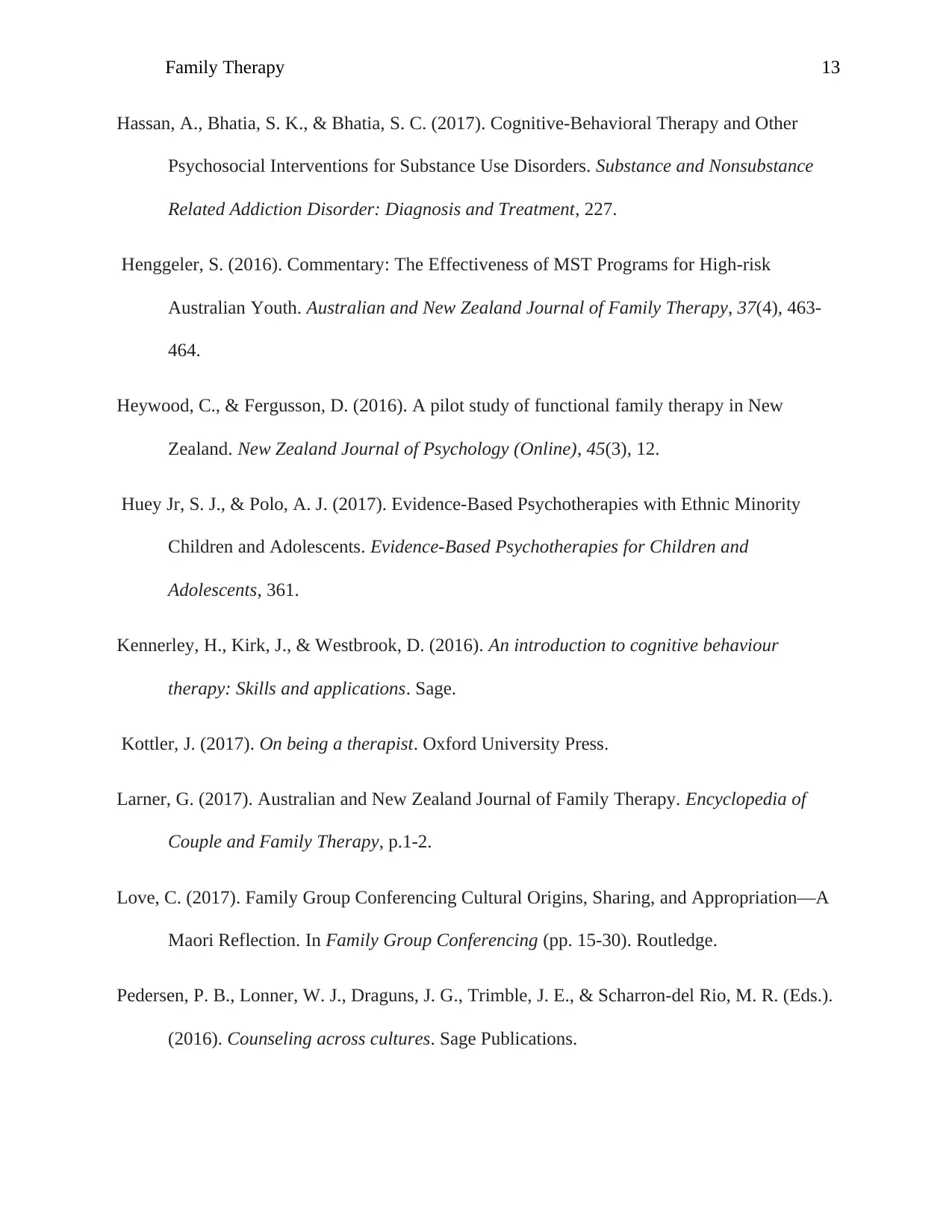
Family Therapy 13
Hassan, A., Bhatia, S. K., & Bhatia, S. C. (2017). Cognitive-Behavioral Therapy and Other
Psychosocial Interventions for Substance Use Disorders. Substance and Nonsubstance
Related Addiction Disorder: Diagnosis and Treatment, 227.
Henggeler, S. (2016). Commentary: The Effectiveness of MST Programs for High‐risk
Australian Youth. Australian and New Zealand Journal of Family Therapy, 37(4), 463-
464.
Heywood, C., & Fergusson, D. (2016). A pilot study of functional family therapy in New
Zealand. New Zealand Journal of Psychology (Online), 45(3), 12.
Huey Jr, S. J., & Polo, A. J. (2017). Evidence-Based Psychotherapies with Ethnic Minority
Children and Adolescents. Evidence-Based Psychotherapies for Children and
Adolescents, 361.
Kennerley, H., Kirk, J., & Westbrook, D. (2016). An introduction to cognitive behaviour
therapy: Skills and applications. Sage.
Kottler, J. (2017). On being a therapist. Oxford University Press.
Larner, G. (2017). Australian and New Zealand Journal of Family Therapy. Encyclopedia of
Couple and Family Therapy, p.1-2.
Love, C. (2017). Family Group Conferencing Cultural Origins, Sharing, and Appropriation—A
Maori Reflection. In Family Group Conferencing (pp. 15-30). Routledge.
Pedersen, P. B., Lonner, W. J., Draguns, J. G., Trimble, J. E., & Scharron-del Rio, M. R. (Eds.).
(2016). Counseling across cultures. Sage Publications.
Hassan, A., Bhatia, S. K., & Bhatia, S. C. (2017). Cognitive-Behavioral Therapy and Other
Psychosocial Interventions for Substance Use Disorders. Substance and Nonsubstance
Related Addiction Disorder: Diagnosis and Treatment, 227.
Henggeler, S. (2016). Commentary: The Effectiveness of MST Programs for High‐risk
Australian Youth. Australian and New Zealand Journal of Family Therapy, 37(4), 463-
464.
Heywood, C., & Fergusson, D. (2016). A pilot study of functional family therapy in New
Zealand. New Zealand Journal of Psychology (Online), 45(3), 12.
Huey Jr, S. J., & Polo, A. J. (2017). Evidence-Based Psychotherapies with Ethnic Minority
Children and Adolescents. Evidence-Based Psychotherapies for Children and
Adolescents, 361.
Kennerley, H., Kirk, J., & Westbrook, D. (2016). An introduction to cognitive behaviour
therapy: Skills and applications. Sage.
Kottler, J. (2017). On being a therapist. Oxford University Press.
Larner, G. (2017). Australian and New Zealand Journal of Family Therapy. Encyclopedia of
Couple and Family Therapy, p.1-2.
Love, C. (2017). Family Group Conferencing Cultural Origins, Sharing, and Appropriation—A
Maori Reflection. In Family Group Conferencing (pp. 15-30). Routledge.
Pedersen, P. B., Lonner, W. J., Draguns, J. G., Trimble, J. E., & Scharron-del Rio, M. R. (Eds.).
(2016). Counseling across cultures. Sage Publications.
Paraphrase This Document
Need a fresh take? Get an instant paraphrase of this document with our AI Paraphraser

Family Therapy 14
Bell. (2017). Foundations of Futures Studies: Volume 2: Values, Objectivity, and the Good
Society. . Routledge.
Burck. (2018). Gender and family therapy. Routledge.
Esterson, L. &. (2016). Laing, R. D., & Esterson, A. . Sanity, madness and the family. .
Routledge.
Hawthorne et al . (2016). Parent spirituality, grief, and mental health at 1 and 3 months after their
infant's/child's death in an intensive care unit. Journal of pediatric nursing, , 31(1), 73-
80.
Jong et al. (2016). de Effects of mindfulness-based cognitive therapy on body awareness in
patients with chronic pain and comorbid depression. Frontiers in psychology, 7, 967.
Olszewski-Kubilius. (2018). The role of the family in talent development. In Handbook of
giftedness in children . Springer, Cham., (pp. 129-147). .
Sexton, H. &. (2016). The Effectiveness of Functional Family Therapy in Reducing Adolescent
Mental Health Risk and Family Adjustment Difficulties in an I rish Context. . Family
Process,, 55(2), 287-304.
Waters. (2016). From human to posthuman: Christian theology and technology in a postmodern
world. . Routledge.
Willig & Rogers. (2017). The SAGE handbook of qualitative research in psychology. . Sage.
Yeung et al. (2016). Examining infertility treatment and early childhood development in the
Upstate KIDS Study. . JAMA pediatrics, , 170(3), 251-258.
Bell. (2017). Foundations of Futures Studies: Volume 2: Values, Objectivity, and the Good
Society. . Routledge.
Burck. (2018). Gender and family therapy. Routledge.
Esterson, L. &. (2016). Laing, R. D., & Esterson, A. . Sanity, madness and the family. .
Routledge.
Hawthorne et al . (2016). Parent spirituality, grief, and mental health at 1 and 3 months after their
infant's/child's death in an intensive care unit. Journal of pediatric nursing, , 31(1), 73-
80.
Jong et al. (2016). de Effects of mindfulness-based cognitive therapy on body awareness in
patients with chronic pain and comorbid depression. Frontiers in psychology, 7, 967.
Olszewski-Kubilius. (2018). The role of the family in talent development. In Handbook of
giftedness in children . Springer, Cham., (pp. 129-147). .
Sexton, H. &. (2016). The Effectiveness of Functional Family Therapy in Reducing Adolescent
Mental Health Risk and Family Adjustment Difficulties in an I rish Context. . Family
Process,, 55(2), 287-304.
Waters. (2016). From human to posthuman: Christian theology and technology in a postmodern
world. . Routledge.
Willig & Rogers. (2017). The SAGE handbook of qualitative research in psychology. . Sage.
Yeung et al. (2016). Examining infertility treatment and early childhood development in the
Upstate KIDS Study. . JAMA pediatrics, , 170(3), 251-258.
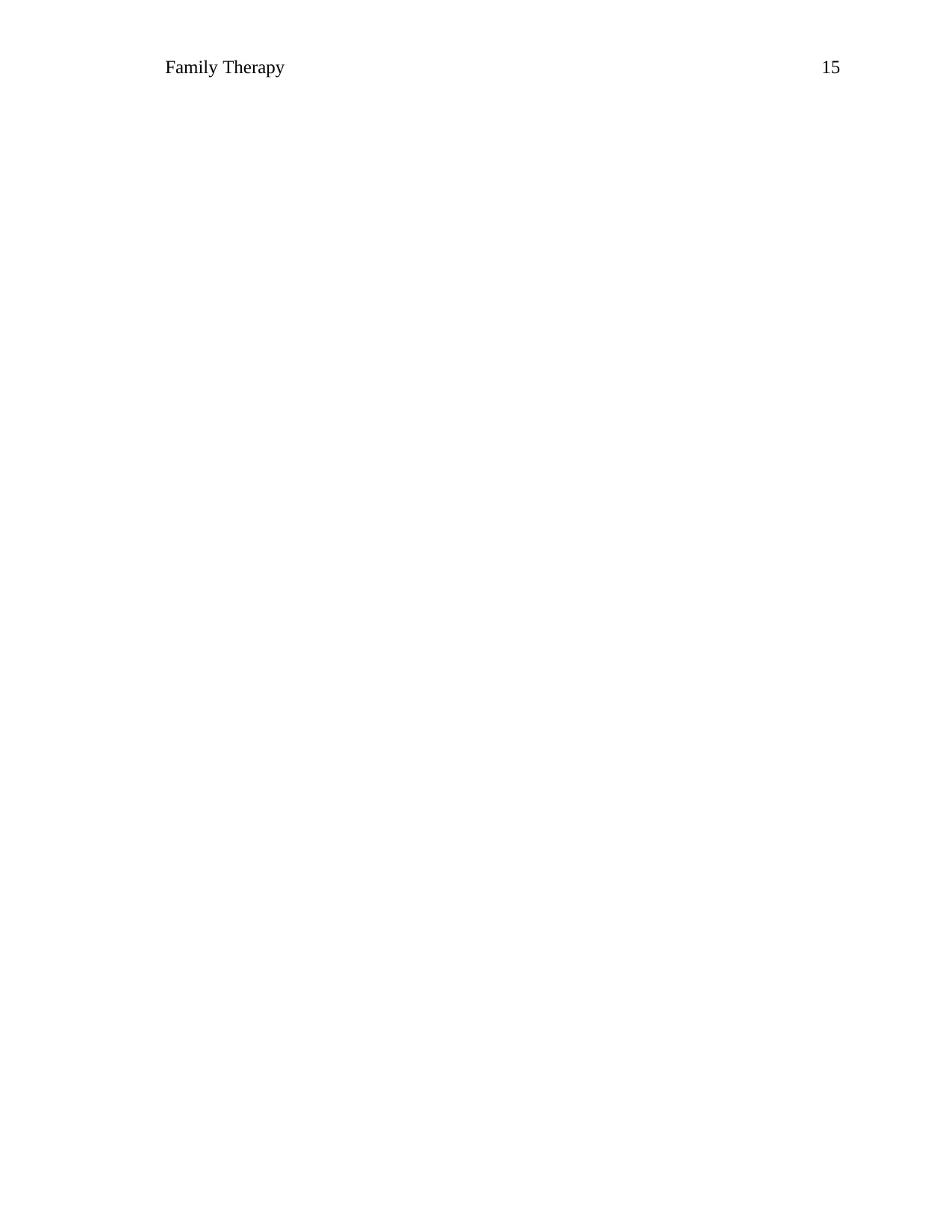
Family Therapy 15
1 out of 15
Related Documents
Your All-in-One AI-Powered Toolkit for Academic Success.
+13062052269
info@desklib.com
Available 24*7 on WhatsApp / Email
![[object Object]](/_next/static/media/star-bottom.7253800d.svg)
Unlock your academic potential
© 2024 | Zucol Services PVT LTD | All rights reserved.




